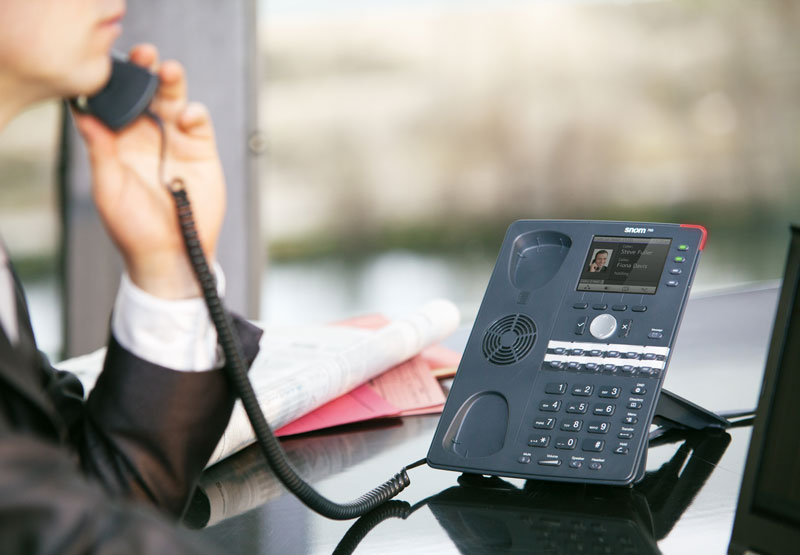Last week we talked about SIP trunking and the history of telephony. We explained how you can connect your VoIP system to the existing PSTN. That’s what happens to your phone calls after they leave the office.
But what about inside your office? Can you integrate your legacy equipment with your VoIP phone system?
That’s what this week’s blog is about.
The main idea is translation. When you get down to it, telephony is just translating a voice into a signal, then translating it back. How that’s been done over the years is fascinating.
You can translate your existing telephones’ signals to VoIP and back.

Circuit switching
Here’s a question: What is the difference between analog and digital telephony?
Well, that’s a bit of a trick question because obviously there are many, many differences. But the primary difference that we would point out is that analog telephony relies on circuit switching, in which a dedicated circuit is established between endpoints, while digital telephony uses packet switching.
What does that mean? Let’s not get too far into the weeds here. But, as they say, knowledge is power!
So. Circuit switching vs packet switching. Remember that all of this is about translating one form of information—the voice—into another form of information, then transporting that information, then reconstituting it back into a voice.
Circuit switching, in telephony, means you have a single continuous connection between one phone and another phone. Have you ever wondered about local calls vs long-distance calls and those three-digit area codes? These are all to do with circuit switching.
To make the networks easier to manage, telephone service providers came up with topologies—blueprints for networks—that separated the telephone network (PSTN) into manageable chunks. These chunks were given three-digit labels: area codes. So if your call created a circuit within the same chunk of the PSTN as the person receiving your call, then you had a local call. If the circuit needed to go out of your chunk, then the telephone operators or system would pass it along, and it would be long-distance.
Circuit switching is an excellent idea, but it’s also limited.
A big problem is that if a circuit is in use, then no one else can use that circuit. If your phone is off the hook, you have created a circuit with the telephone company. That’s why you couldn’t receive a call when your phone was off the hook.
Another big problem is that the system needs to be centralized. You need to have discrete areas for the system to be practical to manage. This means that distance becomes a big issue. Today, we’re used to connecting with anyone or any website around the world. You can’t do that nearly so easily with circuit switching.
To solve these problems, you need to be able to break up the signal without loss of quality. How do you do that? Packet switching.

Packet switching
Packet switching is the fundamental method of data transfer in digital systems, including the Internet.
Imagine a stream of sound. With circuit switching, you need a complete circuit, because that entire stream is being shoved along a single path. Now imagine taking slices of that stream and sending those slices to their recipient in the right order. The recipient hears it as a continuous stream, because the slices are so thin and so expertly done that the breaks aren’t audible.
That’s packet switching.
A stream of sound is translated into digital information: 1s and 0s. For each second of sound, many thousand of samples are taken, which is why you don’t notice any breaks in the sound. That digital information is divided into discrete packets of information. The actual sample of sound is called the payload. A bit of code, the header, is added to signify the beginning and the end of the packet, who should receive the packet, the order of the information, and so on. Then the packet is sent through the network to its recipient. The packets are reorganized, and you hear a phone call.
This is actually the same process for all data on the Internet. Data is broken down into packets, sent along and reorganized.
With packet switching, you don’t need a continuous circuit and you don’t need centralized control.
So, you see, this is all about translating voices into data, breaking that data down, sending packets along, and translating it back.
But you’ve probably been wondering: what does this have to do with my office?

Voices in the office
There are two questions here that need to be asked: What protocol is being used to create packets, and how are those packets being transferred?
Remember from last week that a protocol is something like a language for a digital device. A device needs to be able to recognize and translate a series of packets into a human-comprehensible form. It’s no good for there to be just a stream of 1s and 0s.
The most common protocol for VoIP is SIP, Session Initiation Protocol, and it’s transferred over the Internet. For information on SIP phones, visit our blog: What Is A SIP Phone? An Easy To Understand Explainer.
A stream of SIP data, however, can be translated into data that can be sent over the PSTN. One way to do this is to set up SIP trunking, which sends a large stream of SIP data to an Internet telephony service provider, who do the translating. Or you might have an IP-PBX set up in your office that connects directly to the PSTN.
That’s one way of connecting voices in the office.
But what if you want to go in the opposite direction? What if you want to take traditional telephony and make it VoIP?

Gateways, ATAs and telephony cards
There are specialized devices that help you connect your office by translating your voice data into VoIP.
A gateway is a device that, in a nutshell, translates one form of data into another form. When it comes to telephony, that means translating a stream of SIP traffic, for instance, into analog for listening on an older telephone.
There are gateways for pretty much every situation you can think of. Wherever you need to transform one type of data to another, there you’ll find a gateway. And it’s not only voice data, but also faxes, camera feeds and many other forms. They’re all integrated into the IP network, giving you more control and often reducing your costs significantly.
If you’ve ever wondered why IP Phone Warehouse works with surveillance cameras and video conferencing, this is why. The networking technology is identical. We were already experts in VoIP. We extended that expertise to the increasingly interconnected and expansive world of IP technology.
T1 gateways translate digital data. They’re called that because T1 cables are the standard cables for digital telephony.
Whether the gateway has FXO or FXS ports (or both) is important to pay attention to, because they’re used in different situations. If you’re connecting the cord that comes from Outside, you plug that into an FXO port: O for Outside. If you’re connecting the cord that comes from a phone, you plug that into an FXS port. (FXO and FXS ports can get a bit complicated, so make sure you’re getting the gateway that works for your system. Give us a call if you need help!)
An ATA (analog telephone adapter) is a specific type of gateway that is installed before the IP-PBX in the office, that is, between the analog phones and the control unit. So a number of analog phones could be plugged into an ATA that’s then plugged into an IP-PBX. The adapter translates the analog stream into VoIP data and vice versa, and the analog phone is brought into the VoIP network.
Gateways also come as telephony cards. These are simply gateways that are inserted directly into an IP-PBX. They simplify deployment, are relatively inexpensive and can provide hardware-based echo cancellation to improve sound.
All of these products are translators. They take one type of data and make it another. When you’re interconnecting your office, remember this: Your data can take many shapes. By making it work with IP technology, you’re connecting it to the whole world of the Internet and everything that that enables.

